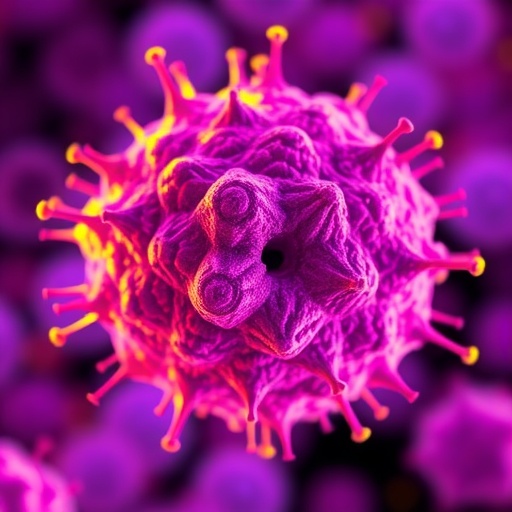In a groundbreaking study set to reshape our understanding of cancer biology, an international team of researchers has revealed that small-cell lung cancer (SCLC) cells can form functional synapses with neurons, integrating directly into the body’s neural circuitry. This novel discovery provides compelling evidence that cancer cells are not merely passive entities multiplying uncontrollably but are also active participants capable of hijacking neural networks to promote their own growth and survival. The research, published in the prestigious journal Nature, opens new horizons for developing targeted therapies against one of the most aggressive and deadly forms of lung cancer.
The existence of synapses—specialized junctions that enable communication between neurons—has historically been thought to occur exclusively within the nervous system and, more recently, within brain tumors originating from neural tissue. This study disrupts that conventional notion by demonstrating that a lung cancer, originating far from the nervous system, can physically and functionally wire itself into neuronal circuits. Such integration underscores a profound level of cancer-host interaction, suggesting that tumors may co-opt the body’s own communication systems to enhance their proliferative capabilities and resist treatments.
Starting with a comprehensive genetic analysis, the investigators identified a subset of genes implicated in synapse formation that are aberrantly expressed in SCLC cells. This discovery paved the way for detailed imaging and electrophysiological studies using both cell cultures and sophisticated mouse models carrying allografts of SCLC. These experiments visually and functionally confirmed the presence of synaptic contacts where lung cancer cells connected with nearby neurons, effectively creating a hybrid interface facilitating bidirectional communication.
The senior authors emphasized the startling extent to which SCLC cells “innervate” and manipulate their microenvironment. Professor Matteo Bergami, a principal investigator at the University of Cologne, noted the remarkable adaptability of these cancer cells in forming synaptic connections with diverse neuronal populations, including sensory and cortical neurons. This plasticity suggests a dynamic and aggressive strategy whereby cancer cells exploit neural inputs to fuel their malignant progression, potentially explaining why SCLC is notorious for rapid growth and early metastasis to the brain.
Central to their findings was the identification of two key neurotransmitters, glutamate and gamma-aminobutyric acid (GABA), which mediate signaling at the neuron-cancer synapses. These neurotransmitters are fundamental to normal brain function, regulating excitatory and inhibitory signals, respectively. The presence of functional glutamate and GABA signaling platforms in SCLC cells indicates that these malignancies do not merely form structural contacts but actively engage in neurochemical communication, co-opting signaling pathways to enhance their survival and proliferation.
Experimental interventions disrupting glutamate signaling yielded promising preclinical results. Pharmacological blockade of this pathway significantly reduced tumor burden in animal models and extended their survival, marking a crucial step toward translating this knowledge into therapeutic interventions. The research team highlighted that targeting neurotransmitter signaling in SCLC offers an innovative route for treatment, possibly in combination with existing chemotherapies, thus providing a multipronged approach to combat resistant cancer forms.
The implications of these findings extend beyond SCLC. The concept that peripheral tumors might establish synaptic-like interactions with neurons challenges current paradigms in oncology and neurobiology, raising the possibility that other cancers might similarly exploit neural circuits. This realization calls for a broader examination of cancer-neuron crosstalk in various malignancies and may spearhead the development of a new class of neuro-targeted oncological therapies.
Collaborating across institutions in Germany, Belgium, and the United States, the research effort was spearheaded by scientists from the University of Cologne, University Hospital Essen, University of Göttingen, Heinrich Heine University Düsseldorf, and prominent partners in Munich, Antwerp, and Stanford. This extensive cooperation was critical for integrating cutting-edge genomic analysis, live-cell imaging, electrophysiology, and in vivo studies, providing a comprehensive portrait of the molecular and functional mechanisms underpinning cancer-neuron synapses.
While the molecular players facilitating synapse formation remain under active investigation, the study suggests that SCLC cells possess molecular machinery reminiscent of neuronal cells, including synaptic scaffolding proteins and receptors. Understanding these components at a molecular level will be essential for devising strategies to selectively disrupt cancer-neuron synapses without damaging normal brain function, a challenge that demands precision oncology coupled with neurobiology insights.
Moreover, the revelation that sensory and cortical neurons can differentially influence SCLC cell proliferation underscores the heterogeneity and complexity of the tumor microenvironment. It posits that the nervous system’s role in cancer progression is nuanced, relying on local circuitry as well as systemic neural influences. Such insights may redefine how metastasis, particularly to the central nervous system, is studied and managed, as the brain’s microenvironment can be uniquely manipulated by invading tumor cells through synaptic integration.
The therapeutic potential of repurposing existing neurotransmitter-blocking drugs, some already approved for neurological disorders, offers a rapid translational pathway. Meanwhile, novel molecules specifically designed to target the unique molecular signatures of cancer synapses are a promising avenue for next-generation therapies. Importantly, this approach aligns with the increasing recognition of tumor microenvironment targeting as a strategy to overcome drug resistance and improve patient outcomes.
This transformative research not only amplifies our understanding of tumor biology but also illuminates the intimate, previously unappreciated dialogue between cancer and the nervous system. It charts a future where cancer may be combated not only through targeting the cancer cells themselves but also by severing the rogue conversations they hold with neural networks, ultimately starving tumors of the inputs they hijack for survival.
In conclusion, the discovery of functional synapses between lung cancer cells and neurons is a landmark advancement in cancer research. It points to an uncharted frontier that bridges neuroscience and oncology, igniting hope for novel interventions that could dramatically alter the prognosis of small-cell lung cancer, a disease that has long defied existing therapies. As researchers continue to unravel the intricacies of neuron-cancer crosstalk, the prospects of more effective and tailored treatments come into clearer view.
Subject of Research: Animals
Article Title: Functional synapses between neurons and small-cell lung cancer
News Publication Date: 10-Sep-2025
Web References: http://dx.doi.org/10.1038/s41586-025-09434-9
Image Credits: Abdulla Chihab, Kristiano Ndoci and Felix Gaedke | University of Cologne
Keywords: small-cell lung cancer, neuron-cancer synapses, glutamate signaling, GABA, tumor microenvironment, neurotransmitter blockade, synapse formation, cancer-neuron communication, targeted therapy, metastasis, experimental mouse model, cancer biology
Tags: aggressive lung cancer researchcancer biology breakthroughscancer cells hijacking neuronscancer treatment resistance mechanismsgenetic analysis of cancerneural circuitry and cancerneuronal synapse integrationnovel cancer therapies developmentsmall cell lung cancersynapse formation and cancertargeted therapies for lung cancertumor-host interactions





